Hector of Homebush
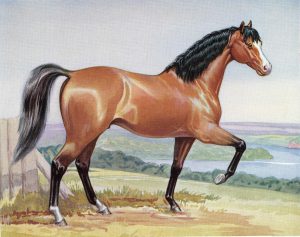
Portrait of Hector from the Douglas M. Barrie book titled The Australian Bloodhorse published by Angus & Robertson in 1956
‘A death took place this week which may be thought worthy of a place in our columns. That fine Arabian horse, Hector, the property of D. Wentworth, Esq, died at his master’s seat at Homebush on Saturday night last, worn out with debility and age – being between 31 and 32 years old. This noble animal was once the property of Colonel Wellesley (now the Duke of Wellington). By the then Colonel, Hector was taken from India to Europe, and from thence he returned to India in the stud of the Marquis Wellesley, brother to his Grace the Duke of Wellington. – After this visit to Europe, it became the lot of the deceased to be thought worthy of the honor of a trip to New South Wales, so that his name might be handed down as having improved the then extremely poor equestrian race. Mr Merchant Campbell, of George Street brought him to this Colony many years since. It is well known that Hector is the progenitor of many excellent horses now amongst us; and that his breed is of the most serviceable kind.’[1]
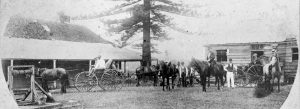
Homebush Farm, 1917. Courtesy State Library of NSW
‘Every horse in Australia is of imported origin.’[2]
Only seven horses arrived with the First Fleet in 1788, acquired from Capetown during the long voyage. By 1793 only one stallion and one mare remained.[3] Stock increased during the next few years but horses remained a rare and valuable commodity in the colony. Elizabeth Macarthur reported in a letter home to Britain in 1795 that a good horse was worth £140 to £150.[4] A census of stock in August 1799 recorded 39 horses and 72 mares in Sydney.
From just four sires were bred the colony’s first racehorses.[5] Douglas M. Barrie, in his book The Australian Bloodhorse, published in 1956, claims that ‘Of all the imports from the East the most significant was Old Hector. He shared with the English horse Northumberland the distinction of being our leading sire prior to 1825.’[6]
Hector was of Arabian breed, foaled in Persia c.1792 and taken to India. It was here that he was purchased by Colonel Arthur Wellesley, later 1st Duke of Wellington, of the Battle of Waterloo fame. Wellington returned to England in 1805 accompanied by two horses, one of whom was Hector, although Hector was soon sent back to Wellesley’s brother’s stud in Calcutta. The Marquis Wellesley was then Governor-General of India.[7] From here he was purchased by merchant, Robert Campbell and brought to Sydney. Campbell became a major landowner – his estates included Duntroon in Canberra. D’Arcy Wentworth purchased the bay Arabian horse, standing almost 16 hands, in late 1812 when several of Hector’s sons and daughters were also offered for sale.[8]
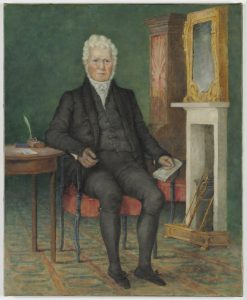
Merchant, Robert Campbell, 1834 by Charles Rodius. Courtesy State Library of NSW
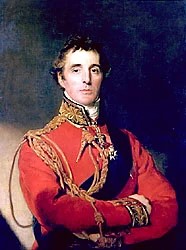
Arthur Wellesley, 1st Duke of Wellington by Sir Thomas Lawrence. Courtesy the Granger Collection, New York
Wentworth advertised Hector’s services for breeding ‘during the season’ at Homebush from 1813, although on Fridays and Saturdays he was still available in Sydney itself.[9] In this same year, D’Arcy Wentworth’s son, William Charles Wentworth crossed the Blue Mountains with Blaxland and Lawson – along with four horses and five dogs. As both Wentworth and Lawson were associated with the fledgling racing industry in the colony, it seems likely that their horses were of good quality and may have included Hector’s own progeny.
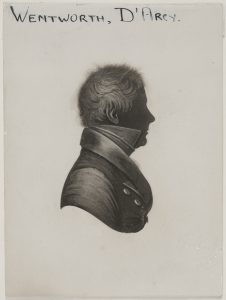
D’Arcy Wentworth. Courtesy State Library of NSW
The price of Hector’s services ranged between three and seven guineas during the next 10 years and many advertisements highlighted his fine qualities. D’Arcy Wentworth offered the services of several other stallions too, including Jock, Grey Galloway and his ‘full-blood’ Derwent, bred in Tasmania. Arab and Persian horses were then known as bloodhorses.[10]
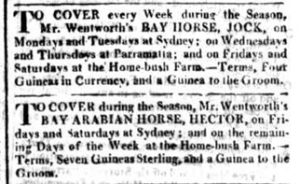
The Sydney Gazette and New South Wales Advertiser 11 September 1813 p.2
D’Arcy Wentworth, by this time, was principal surgeon of the Civil Medical Department and a Justice of the Peace. Governor Macquarie had also placed him in charge of his reformed police force and appointed him treasurer of the Police Fund.[11] Wentworth had purchased Home-Bush Farm from Thomas Laycock in 1808.
Hector was kept very busy. There were few horses of quality in the early days of the colony but Hector was one of the best. During September 1820 Simeon Lord offered one of his progeny – ‘Young Hector’ for sale at his auction. ‘Any eulogium upon him is totally unnecessary, his excellent qualities being perfectly well known throughout the Colony.’[12]
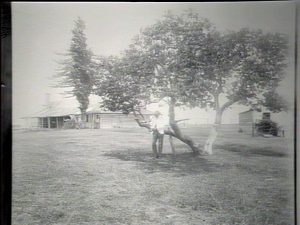
A later back view of Wentworth’s Homebush homestead. Courtesy State Library of NSW
Hector was a major influence in early Sydney bloodstock breeding.[13] ‘He was the most outstanding sire during the first decade of Australian racing.’[14] For many decades after his death his descendants were offered for sale and stud boasting of their illustrious ancestor’s bloodline. No doubt many of them raced at the Homebush Racecourse which was established on Wentworth’s land in 1841. You can read more about the Homebush Racecourse, which closed in 1859, at: https://strathfieldheritage.com/parks-and-reserves/homebush-racecourse/
Later descendants of these fine early horses included the ‘walers’ that equipped our Light Horse brigades during World War I. These became sought after for cavalry units in other countries, such as India, too and were mainly of thoroughbred origin.
Douglas M. Barrie lists Hector’s many notable progeny in his book and concludes that Hector ‘was without doubt the most successful stallion imported to Australia prior to 1820, and a valuable ancestor in any thoroughbred pedigree.’[15]
By J.J. MacRitchie
Local Studies Advisor
References
[1] The Sydney Gazette and New South Wales Advertiser 1 January 1824 p.2 https://trove.nla.gov.au/newspaper/article/2182505 [2] Barrie Douglas M. The Australian Bloodhorse. Sydney: Angus and Robertson, 1956 p.3[3] Barrie p.8
[4] Letter from Elizabeth Macarthur to Miss Kingdon, 1 September 1795 https://gutenberg.net.au/ebooks13/1302011h.html
[5] Barrie p.13
[6] Barrie p.96
[7] Barrie p.97
[8] The Sydney Gazette and New South Wales Advertiser 14 November 1812 p.2 https://trove.nla.gov.au/newspaper/article/628571
[9] The Sydney Gazette and New South Wales Advertiser 4 September 1813 p.2 https://trove.nla.gov.au/newspaper/article/628764
[10] Barrie p.98
[11] J. J. Auchmuty, ‘Wentworth, D’Arcy (1762–1827)’, Australian Dictionary of Biography, National Centre of Biography, Australian National University, https://adb.anu.edu.au/biography/wentworth-darcy-1545/text3917
[12] The Sydney Gazette and New South Wales Advertiser 23 September 1820 p.3 https://trove.nla.gov.au/newspaper/article/2179763
[13] Thoroughbred Heritage https://www.tbheritage.com/HistoricDams/ColonMares/C26.html
[14] Arabian Horse Society of Australia A Brief History of the Arabian Horse in Australia https://www.ahsa.asn.au/a-brief-history-of-the-arabian-horse-in-australia/
[15] Barrie p.100
